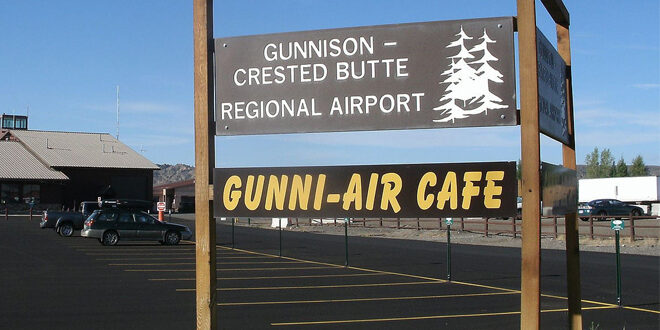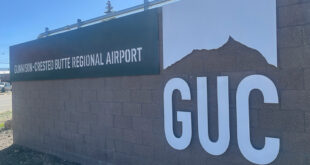South Valley hit harder this summer
By Katherine Nettles
In an update to Gunnison County commissioners this week, Gunnison County Tourism and Prosperity Partnership (TAPP) representatives reviewed the past winter and summer, offered their vision of what to focus on next and gave some early signs of how they hope to craft their budget in the coming months to prepare for 2025.
TAPP executive director John Norton started off by reviewing the four main TAPP principles—supporting and advertising summer and winter trails; growing synergies between various groups within the county; promoting efficiencies, technology and learning; and embodying nimbleness and speed in what they do.
Eyes on the competition
Norton reflected on a recent TAPP retreat to Durango during which he learned about various plans for both the city and nearby ski resort Purgatory to make major investments in infrastructure and amenities to strengthen its tourism.
“Purgatory plans to spend $100 million in the next 10 years,” said Norton. He added that the Durango hot springs are undergoing a $14 million renovation, and the bike park has had an estimated $10 million infusion to create an events amphitheater, camping, BMX trails and over 2,000 acres of mountain bike trails that allow e-bikes. He also reviewed last year’s visit to Steamboat and their massive infusion of capital to the town and ski resort there as well.
“We’re doing pretty well but we cannot indefinitely keep beating the market,” Norton said of Crested Butte Mountain Resort (CBMR). He lamented that he has reached out to CBMR repeatedly to share ideas and encourage more investment in resort amenities such as new terrain, chair lifts, restaurants and base-area upgrades, “But I’m not getting anywhere.”
TAPP marketing director Andrew Sandstrom said, as his team looks back on 2024, he foresees some challenges ahead for TAPP in keeping tourism and economic development stable. “There seems to be a slowdown on the horizon,” he said, as evidenced in industry-wide skier number reductions, fewer investments and the election cycle effects of uncertainty and advertising difficulty.
“Thus far we are outpacing the competitive set, but we can’t keep relying on that,” he said, and echoed Norton’s concerns about the lack of large tourist attraction investment. “I’d like to reiterate the need for this, not just on the visitor side but also on the locals and business side. It is our amenities in this community that drive people to want to be here and work the extra mile to start a business here—as well as visiting,” he said. Acknowledging that tourism is the largest part of the local economy, he said it’s important that tourism support economic development. “We also need to invest in other pieces like growing our economy beyond tourism.”
Sandstrom cautioned that although from January through July the Local Marketing District (LMD) revenue was up 11%, there have been fewer visitors overall. “We cannot continue to grow the LMD if we continue seeing fewer visitor nights. The only reason we’re up in LMD revenue is rate gains,” he said of lodging.
He said last winter started off very strong, particularly in the South Valley. Then in summer, people’s stays dropped by about one night on average. He said it might be that lodging rates have become prohibitive and encourage shorter stays.
The other challenge Sandstrom named was critical mass. “How do we get to a point where we’re big enough that we can begin developing amenities that make it easier to live here. One of the things we saw both in Steamboat and in Durango that we talked about is mountain town life. They have a Walgreens, they’ve got a Target. They’ve got a dermatologist: we have to reach critical mass to get some of those services that make it more attractive for visitors, businesses and locals. That’s another area that we are keeping an eye on.”
He said Durango pulls from a five-county area of about 100,000 people and they still struggle to have critical mass for major investments.
County commissioner Jonathan Houck likened the critical mass idea to the circular argument of recruiting more students to Western Colorado University if there were a more vibrant Gunnison nightlife. “Well, we could have more downtown nightlife, but we need more students,” he said. “Often that critical mass concept triggers other discussions for communities.”
Sandstrom said the amenities we do have in the Gunnison Valley, namely great trails and trail access, have helped win over a younger demographic that will endure for years to come if their loyalty can be earned.
“We’re attracting a demographic that our competitors want,” he said, describing them as “a young, lively group that will hold well into the future,” and enjoy mountain biking.
Sandstrom said they have seen huge growth in traffic to the TAPP website, but people don’t spend as much time there. And lodging searches were way up, but referrals, while also up, were not as high as the traffic should indicate. “It’s not growing at the same rate. So, we’re keeping an eye on that diminishing engagement.”
South Valley slump
Sandstrom also named a discrepancy between North Valley and South Valley tourism revenue, and said the Highway 50 bridge closure this spring and summer had a pronounced impact on Gunnison tax revenues, which was down about 12% for the year through July. Crested Butte was only down 1% for the same period. “We’re seeing a bit of disparity and trying to think about how we can address that,” he said.
One solution he offered is to continue promoting flights, which he said again benefits visitors, businesses and locals. He noted that if the RTA is not paying rate guarantees to airlines, they keep more money to run free bus services and offer more amenities that benefit locals.
Houck asked if there being only five main lodging properties in Gunnison is a factor. “When most communities are getting rebooted cool old boutique hotel/motels, in Gunnison they’ve all become long-term rentals because of the housing crisis…is that impacting things?” he asked. “If there is a lack of availability in Gunnison, and the prices have come up maybe people are going to Crested Butte.”
Sandstrom said that several engineers and long-term workers on the bridge project helped fill Gunnison lodges this summer, but the shops and restaurants saw fewer patrons. “The volume of business on Main Street has been more impacted than current tax collections on lodging. But it’s an early warning sign.”
TAPP’s plan for 2025 is to promote flights, which are performing “extremely well,” with extra focus on shoulder seasons and winter; to focus more on the South Valley and bump up spending on gravel biking markets; and somehow converting people who camp to choose lodging during the busiest four to six weeks of summer.
Norton commented that the North Valley’s transition to designated camping without a reservation system leads to people camping illegally and causing resource damage. “There’s also opportunity to create commercial campsites,” said Sandstrom.
One fortuitous event taking place this week is that Mt. Crested Butte is hosting the Colorado Governor’s Tourism Conference September 25 through 28. The event is held through the Colorado Tourism Office, part of the Office of Economic Development and International Trade, and focuses on informational sessions, trends and networking opportunities tailored to advance tourism in Colorado. Tourism professionals from all over the world attend the conference and we’d say their timing is pretty good given the fall weather.
 The Crested Butte News Serving the Gunnison Valley since 1999
The Crested Butte News Serving the Gunnison Valley since 1999


